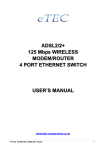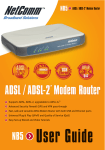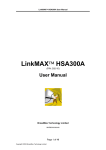Download Allied Telesis AT-AR256E User's Manual
Transcript
Web Interface User Guide Allied Telesyn AT-AR256E 4-Port ADSL Router Rev. 1.0 1. Introduction................................................................................................................ 4 1.1 Main Features...................................................................................................... 4 2. Your Gateway at a Glance...................................................................................... 6 2.1 Ports and Buttons ................................................................................................ 6 2.2 LED Description................................................................................................. 6 3. Installing Your ADSL Router................................................................................... 7 4. Setting Up Your ADSL Router................................................................................ 8 4.1 Log into Your ADSL Router .............................................................................. 8 4.2 Quick Start .......................................................................................................... 8 4.3 Setup (For Advance User)................................................................................... 9 4.3.1 Wide Area Network Connection............................................................... 10 4.3.2 Local Area Network Connection .............................................................. 10 4.4 Configuring the WAN ....................................................................................... 10 4.4.1 New Connection........................................................................................ 11 4.4.2 Modify an Existing Connection................................................................ 17 4.4.3 Modem Setup ............................................................................................ 17 4.5 Configuring the LAN ........................................................................................ 17 4.5.1 Enable/Disable DHCP............................................................................... 18 4.5.2 Changing the ADSL Router IP Address ................................................... 19 4.5.3 Firewall/NAT Services ............................................................................. 20 4.6 Advanced (For Advance User Only) ................................................................ 20 4.6.1 UPnP ......................................................................................................... 20 4.6.2 Port Forwarding ........................................................................................ 21 4.6.3 Advanced Security.................................................................................... 22 4.6.4 Access Control.......................................................................................... 24 4.6.5 LAN Clients .............................................................................................. 24 4.6.6 MAC Address Filters ................................................................................ 24 4.6.7 Multicast.................................................................................................... 25 4.6.8 Static Routing............................................................................................ 26 4.6.9 Dynamic Routing ...................................................................................... 27 4.7 Tools.................................................................................................................. 28 4.7.1 System Commands.................................................................................... 28 4.7.2 User Management ..................................................................................... 29 4.7.3 Update Firmware....................................................................................... 29 4.7.4 Ping Test ................................................................................................... 30 4.7.5 Modem Test .............................................................................................. 30 4.8 Status ................................................................................................................. 30 4.8.1 Network Statistics ..................................................................................... 30 4.8.2 Connection Status ..................................................................................... 31 4.8.3 DHCP Clients............................................................................................ 31 4.8.4 Modem Status ........................................................................................... 31 4.8.5 Product Information.................................................................................. 31 4.8.6 System Log ............................................................................................... 31 5. Appendix A: Troubleshooting ............................................................................... 32 5.1 The ADSL Router Is Not Functional................................................................ 32 -2- 5.2 I Can’t Connect To The ADSL Router. ............................................................ 32 5.3 The DSL Link LED Continues To Blink But Does Not Stop........................... 32 5.4 The DSL Link LED Is Always Off................................................................... 33 6. ADSL Router Terms............................................................................................... 34 -3- 1. Introduction The AT-AR256E 4-Port ADSL Router is the perfect high speed WAN bridge/router. This fullfeatured product is specifically designed to connect to the Internet, and directly connect to your local area network via high speed 10/100Mbps Ethernet. The ADSL router also has full NAT firewall and DMZ services to block unwanted users from accessing your network. For gaming users, the ADSL router is already pre-configured for several low latency game ports. Just click on the game you are playing online and the rest is done for you. The ADSL router is fully compatible with all computers. As long as your computer has a Ethernet interface and is running a TCP/IP stack, the computer can have high speed WAN access. So, plug in the ADSL router (refer to Quick Installation Guide), configure it (per your ISP’s requirements) and enjoy fast Internet access like never before. 1.1 Main Features ADSL/ATM Support • • • • • • • • • • ANSI T1.413 issue 2, ITU-T G.992.1 (G.dmt) and G.992.2 (G.lite) compliant ADSL2, ADSL2+, RE-ADSL Ready Rate Adaptive modem at 32Kbps steps Dynamic Adaptive Equalisation to improve Carrier’s service area Bridge Tap Mitigation support ATM Layer with Traffic shaping QoS Support (UBR, CBR, VBR-rt, VBR-nrt) AAL ATM Attributes – AAL5 Multiple PVC up to 8 support Spectral compatibility with POTS F5 OAM Loopback/Send and Receive Encapsulation Support • • • • • • RFC2684 Bridge and Routed LLC and VC Mux support RFC2364 PPPoA Client support RFC2516 PPPoE Client support RFC2225/RFC1577 Classical IP Support Transparent Bridge Support PAP/CHAP/MS-CHAP for Password Authentication Support Network Support • • • • • • • • • • • • • Static IP, Dynamic RIP routing support IP/TCP/UDP/ICMP/ARP/RARP Application Support Network Address Translation (NAT) Port Mapping/Forwarding Easy setup of Port Forwarding rules for popular Games/Application NAT Application Level Gateway for popular applications DHCP Server/Relay/client DNS Relay Agent DMZ support Single Session IPsec and PPTP/L2TP VPN pass-through support PPP Always on with configurable timeout PPP Dial on Demand Universal Plug and Play Support -4- Management Support • • • • • • • Web Based HTTP management GUI TFTP/FTP Support for Firmware Upgrade Web Based Firmware Upgrade (Local) Soft Factory Reset Button via Web GUI Telnet/CLI (Read Only) Syslog Support Firmware upgradeable for future feature enhancement Security Support • • • • • NAT for basic Firewall support Packet Filtering Firewall Support Stateful Packet Inspection Support Protection against Denial of Service attacks Password Authentication to Modem External Connectors • • • • • 1 x RJ-11 Telephone socket for ADSL 4 x RJ-45 for 10/100Base-T Ethernet (Auto MDI/MDI-X) 1 x DC Jack for Power Input 1 x Factory Default Reset Button 1 x On/Off Power Switch -5- 2. Your Gateway at a Glance The AT-AR256E 4-Port ADSL Router has several ports and LEDs. Let’s take a look at them. 2.1 Ports and Buttons Reset to Factory Defaults: The reset to factory defaults feature will set the ADSL router back to its factory default configuration. If you had forgotten the login password, you may need to place the ADSL router into its factory default settings. Note that while the ADSL router is resetting, you will loose the ability to communicate with the ADSL router via the web interface. To reset the ADSL router, simply press the reset button for about 10 seconds. The ADSL router will be reset to its factory defaults and after about 30 ~ 40 seconds the ADSL router will become operational again. Local Area Network (LAN) ports: Connect to Ethernet network devices such as computers, hubs, switches or routers. The AT-AR256E has an integral 4-port switch with auto MDI/MDI-X feature which supports both straight and crossover cables. DC input: This is where you connect the power adapter. Make sure to observe the proper power requirements. The required power is 9 volts. Use the power adapter provided. DSL port: This is the WAN interface that connects directly to your telephone wall socket. 2.2 LED Description 1. POWER Lights up when power is supplied to the ADSL router. 2. ETH/ACT Lights up when the Ethernet cable is properly connected from your Ethernet network card to the ADSL router. Flickers when the ADSL router is transmitting/receiving data. 3. DSL Lights up when the ADSL connection is established. Flickers when the ADSL router is trying to establish a connection to your ADSL Provider. 4. INTERNET Lights up when the PPP connection is established. -6- 3. 1. 2. 3. Installing Your ADSL Router Locate an optimum location for the ADSL router. For connections to the Ethernet and DSL interfaces, please refer to the Quick Installation Guide. Connect the power adapter. Depending on the type of network, you may want to connect the power adapter to an Uninterruptible Power Supply (UPS). Only use the power adapter supplied with the ADSL router. A different power adapter may damage the product. Now that the hardware installation is completed, proceed to 4. Setting Up Your ADSL Router -7- 4. Setting Up Your ADSL Router This section will guide you through the ADSL router’s configuration. The ADSL router is shipped with a standard PPP configuration. 4.1 Log into Your ADSL Router To configure the ADSL router, launch your web browser. You may get an error message at this point; this is normal. Do not panic! Type the default IP address (192.168.1.1) press the Enter key and the following page, shown in Figure 1 will appear. The default username is admin (case-sensitive) and the password is admin (case-sensitive). Note: Before setting up the ADSL router, make sure you have followed the Quick Installation Guide. You should have your computers configured for DHCP mode and have proxies disabled on your browser. If you access the ADSL router and instead of getting a login page, the browser instead displays a login redirection page, you should check your browser's setting and verify that JavaScript support is enabled. Also, if you do not get the page shown in Figure 1, you may need to delete your temporary Internet files (basically flush the cached web pages). Figure 1 (Modem Access) 4.2 Quick Start The first page (Figure 2) that appears after the login page is the Quick Start page. Depending on the country that you reside in, some profiles have been preset for the VPI/VCI and type of encapsulation. For example, if you reside in New Zealand, click on the button for New Zealand and then click Next. The next page will display the preset profile of VPI=0, VCI=100 and encapsulation type is PPPoA VC-MUX. If this is not correct, select Customise Settings and enter the VPI and VCI values. If the A DSL service is PPPoA or PPPoE, you will also need to enter the username and password which your ADSL Provider or ISP will supply to you. -8- The Quick Start page is meant for basic users who only require easy and seamless connectivity to the Internet, without worrying about any other advance configuration setting. For more advanced setup, please proceed to the next section. Important: After clicking on Connect, please be sure to “Save Settings” to register the username / password or any other changes. Figure 2 (Quick Start page) 4.3 Setup (For Advance User) From this page the user can setup the ADSL router (configure the LAN and WAN connections ), configure the advanced configuration options within the ADSL router (security, routing and filtering), access tools that are helpful for debug purposes, obtain the status of the modem and view the extensive online help. To setup the ADSL router with a basic configuration, select Setup. Figure 3 illustrates the setup page. The page is broken into two subsections, the WAN configuration and the LAN configuration. Before configuring the ADSL router, there are several concepts that you should be familiar with on how your new ADSL router works. Please take a moment to familiarise yourself with these concepts, as it should make the configuration much easier. -9- Figure 3 (Setup page) 4.3.1 Wide Area Network Connection On the other side of the ADSL router is where your Wide Area Network (WAN) connection; also referred to as a broadband connection. This WAN connection is different for every WAN provider. Most of the configuration you will perform will be in this area. 4.3.2 Local Area Network Connection On one side of the ADSL router, you have your own Local Area Network (LAN) connections. This is where you plug in your local computers to the ADSL router. The ADSL router is normally configured to automatically provide all the computers on your network with Internet addresses. 4.4 Configuring the WAN Before the gateway will pass any data between the LAN interface(s) and the WAN interface, the WAN side of the modem must be configured. Depending on your ADSL Provider or ISP, you will need some or all of the information outlined below before you can properly configure the WAN: • Your ADSL VPI and VCI values • Your ADSL encapsulation type and multiplexing • Your ADSL training mode (default is MMODE) • For PPPoA and PPPoE users, you also need these values from your ISP: • Your username and password • For RFC 1483 users, you may need these values from your ISP: • Your ADSL fixed WAN IP address • Your Subnet Mask • Your Default Gateway • Your primary DNS IP address - 10 - Since multiple users can use the ADSL router, the ADSL router can simultaneously support multiple connection types; hence, the user must set up different profiles for each connection. The ADSL router supports the following protocols: • DHCP • RFC2364 / PPPoA • RFC2516 / PPPoE • Static • Bridged • RFC1577 / CLIP . 4.4.1 New Connection A new connection is basically a virtual connection. The ADSL router can support up to 8 different (unique) virtual connections. If you have multiple different virtual connections, you may need to utilise the static and dynamic routing capabilities of the modem to pass data correctly. 4.4.1.1 Bridged Gateway Profile and Connection A pure bridged connection does not assign a IP address to the WAN interface. NAT and firewall rules are not enabled. This connection method makes the ADSL router act as a hub, and just passes packets across the WAN interface to the LAN interface. To configure the ADSL router as a bridge, click on Setup and then click on New Connection. The default PPPoE connection setup is displayed. At the Type field select Bridge and the Bridge connection setup page is displayed (see Figure 4). Give your Bridge connection a unique name; the name must not have spaces and cannot begin with numbers. In this case the unique name is called Bridge. Select the encapsulation type (LLC or VC); if you are not sure, just use the default mode. Select the VPI and VCI settings; your ADSL Provider or ISP will supply these; in this case, the ADSL Provider is using 0,100. Also select the Quality of Service (QoS); leave the default value if you are unsure or the ISP did not provide this information. Figure 4 (Bridge Connection Setup) - 11 - To complete the connection, you must now click the Apply button. The Apply button will temporarily save this connection. To make the change permanent, you need to click on Save Settings. At the system commands page, click on Save All. 4.4.1.2 PPPoA Connection Setup PPPoA is also known as RFC 2364. It is a method of encapsulating PPP packets over ATM cells which are carried over the ADSL. PPP or Point-to-Point Protocol is a method of establishing a network connection / session between network hosts. It usually provides a mechanism of authenticating users. LLC and VC are two different methods of encapsulating the PPP packet. Contact your ISP to make sure which encapsulation is being supported. By selecting PPPoA, you are forcing the ADSL router to terminate the PPPoA connection. The advantage is that the PPPoA termination is done within the ADSL router and not on your computer; this frees up your computer’s resources and allows multiple users to utilise the PPPoA connection. To configure the gateway for PPPoA, click on Setup and then click on New Connection. The default PPPoE connection setup is displayed. At the Type field select PPPoA and the PPPoA connection setup page is displayed; Figure 5 illustrates a typical PPPoA configuration. Give your PPPoA connection a unique name; the name must not have spaces and cannot begin with numbers. In this case, the unique name is called PPPoA1. Select the encapsulation type (LLC or VC); if you are not sure, just use the default mode. Select the VPI and VCI settings; your ADSL Provider or ISP will supply these; in this case, the ADSL Provider is using 0,100. Also select the Quality of Service (QoS); leave the default value if you are unsure or the ISP did not provide this information. The following is a description of the different options: a. Username: The username for the PPPoA access; this is provided by your ADSL Provider or ISP. b. Password: The password for the PPPoA access; this is provided by your ADSL Provider or ISP. c. On-Demand: Enables on-demand mode. The connection will disconnect if no activity is detected after the specified idle timeout value. d. Idle Timeout: Specifies that PPPoA connection should disconnect if the link has no activity detected for n seconds. This field is used in conjunction with the On-Demand feature. To ensure that the link is always active, enter a 0 in this field. e. Keep Alive: When on-demand option is not enabled, this value specifies the time to wait without being connected to your provider before terminating the connection. To ensure that the link is always active, enter a 0 in this field. f. Set Route: Specify this connection as the default route. g. MRU: Maximum Receive Unit the A DSL connection can receive. It is a negotiated value that asks the Provider to send packets of no more than n bytes. The maximum specified value is 1500, although some ADSL Providers/ISPs require a larger value. The minimum MRU value is 128. - 12 - Figure 5 (PPPoA Connection Setup) To complete the connection, you must now click the Apply button. The Apply button will temporarily save this connection. To make the change permanent, you need to click on Save Settings (at the side of the page). At the system commands page, click on Save All. 4.4.1.3 PPPoE Connection Setup PPPoE is also known as RFC 2516. It is a method of encapsulating PPP packets over Ethernet. PPP or Point-to-Point Protocol is a method of establishing a network connection/session between network hosts. It usually provides a mechanism for authenticating users. To configure the gateway for PPPoE, click on Setup and then click on New Connection. The default PPPoE connection setup is displayed. At the Type field select PPPoE and the PPPoE connection setup page is displayed; Figure 6 illustrates a typical PPPoE configuration. Give your PPPoE connection a unique name; the name must not have spaces and cannot begin with numbers. In this case, the unique name is called PPPoE1. Select the encapsulation type (LLC or VC); if you are not sure, just use the default mode. Select the VPI and VCI settings; your ADSL Provider or ISP will supply these; in this case, the ADSL Provider is using 0,100. Also select the Quality of Service (QoS); leave the default value if you are unsure or the ISP did not provide this information. The following is a description of the different options: a. Username: The username for the PPPoE access; this is provided by your ADSL Provider or ISP. b. Password: The password for the PPPoE access; this is provided by your ADSL Provider or ISP. c. On-Demand: Enables on-demand mode. The connection will disconnect if no activity is detected after the specified idle timeout value. d. Idle Timeout: Specifies that PPPoE connection should disconnect if the link has no activity detected for n seconds. This field is used in conjunction with the On-Demand feature. To ensure that the link is always active, enter a 0 in this field. - 13 - e. f. g. h. Keep Alive: When on-demand option is not enabled, this value specifies the time to wait without being connected to your provider before terminating the connection. To ensure that the link is always active, enter a 0 in this field. Set Route: Specify this connection as the default route. MRU: Maximum Receive Unit the A DSL connection can receive. It is a negotiated value that asks the Provider to send packets of no more than n bytes. The maximum specified value is 1500, although some ADSL Providers/ISPs require a larger value. The minimum MRU value is 128. Enforce MRU: Check this box if you experience problems accessing the Internet over a PPPoE connection. This feature will force all TCP traffic to conform with PPP MRU, by changing TCP Maximum Segment Size to PPP MRU. Figure 6 (PPPoE Connection Setup) To complete the connection, you must now click the Apply button. The Apply button will temporarily save this connection. To make the change permanent, you need to click on Save Settings (at the side of the page). At the system commands page, click on Save All. 4.4.1.4 DHCP Connection Setup Dynamic Host Configuration Protocol (DHCP) allows the ADSL router to automatically obtain the IP address from the server. This option is commonly used in situations where IP is dynamically assigned and is not known prior to assignment. To configure the ADSL router for a DHCP connection, click on Setup and then click on New Connection. The default DHCP connection setup is displayed. At the Type field, select DHCP and the DHCP connection setup page is displayed; Figure 7 illustrates a typical DHCP configuration. Give your DHCP connection a unique name; the name must not have spaces and cannot begin with numbers. In this case, the unique name is called DHCP1. Select the encapsulation type (LLC or VC); if you are not sure, just use the default mode. Select the VPI and VCI settings; your ADSL Provider or ISP will supply these; in this case, the A DSL Provider is - 14 - using 0,100. Also select the Quality of Service (QoS); leave the default value if you are unsure or the ISP did not provide this information. If your ADS L is connected and your A DSL Provider/ISP is supporting DHCP, you can click the renew button and the gateway will retrieve an IP address, Subnet mask, and Gateway address. At anytime, you can renew the DHCP address by clicking on the renew button; in most cases, you will never have to use this button. Figure 7 (DHCP Connection Setup) To complete the connection, you must now click the Apply button. The Apply button will temporarily save this connection. To make the change permanent, you need to click on Save Settings (at the side of the page). At the system commands page, click on Save All. 4.4.1.5 Static Connection Setup Static is used whenever a known static IP is assigned. The accompanying information such as the Subnet mask and the gateway should also be specified. Up to three Domain Name Server (DNS) addresses can also be specified. These servers would enable you to have access to other web servers. Valid IP address range is from 0.0.0.0 to 255.255.255.255. To configure the ADSL router for a Static connection, click on Setup and then click on New Connection. The default Static connection setup is displayed. At the Type field select Static and the Static connection setup page is displayed; Figure 8 illustrates a typical Static configuration. Give your Static connection a unique name; the name must not have spaces and cannot begin with numbers. In this case, the unique name is called STATIC1. Select the encapsulation type (LLC or VC); if you are not sure, just use the default mode. Select the VPI and VCI settings; your ADSL Provider or ISP will supply these; in this case the A DSL Provider is using 0,35. Also select the Quality of S ervice (QoS); leave the default value if you are unsure or the ISP did not provide this information. You can also enable Network Address Translation (NAT) and the Firewall options. If you are unsure, leave these in the default mode. - 15 - Based upon the information your A DSL Provider/ISP provided, enter your assigned IP address, Subnet Mask, Default Gateway (if provided), and Domain Name Service (DNS) values (if provided). For the static configuration, you can also select a bridge connection or a routed connection. Since static IP address is typically used to host web servers, you may want to use a bridge connection. Figure 8 (Static Connection Setup) To complete the connection, you must now click the Apply button. The Apply button will temporarily save this connection. To make the change permanent, you need to click on Save Settings (at the side of the page). At the system commands page, click on Save All. 4.4.1.6 Classical IP over ATM (CLIP, defined in RFC1577) Connection Setup The Classical IP over ATM (CLIP) support provides the ability to transmit IP packets over a ATM network, CLIP support will encapsulate IP in a AAL5 Packet Data Unit (PDU) frame using RFC1577 and it utilises a ATM aware version of the ARP protocol (ATMARP support only allows for PVC support; it does not support SVC). To configure the ADSL router for a CLIP connection, click on Setup and then click on New Connection. The default CLIP connection setup is displayed. At the Type field select CLIP and the CLIP connection setup page is displayed; Figure 9 illustrates a typical CLIP configuration. Give your CLIP connection a unique name; the name must not have spaces and cannot begin with numbers. In this case, the unique name is called CLIP1. Select the VPI and VCI settings; your ADSL Provider or ISP will supply these; in this case, the ADSL Provider is using 0,101. Also select the Quality of Service (QoS); leave the default value if you are unsure or the ISP did not provide this information. You can also enable Network Address Translation (NAT) and the Firewall options. If you are unsure, leave these in the default mode. - 16 - Figure 9 (CLIP Connection Setup) To complete the connection, you must now click the Apply button. The Apply button will temporarily save this connection. To make the change permanent, you need to click on Save Settings (at the side of the page). At the system commands page, click on Save All. 4.4.2 Modify an Existing Connection To modify an existing connection, click setup and then click the connection you want to modify. The connections are listed as Connection 0 through Connection 7. As a note, if you delete the connection, to make the change permanent, you need to click on Save Settings (at the side of the page). At the system commands page, click on Save All. 4.4.3 Modem Setup To configure the ADSL modulation type, Click setup. Under WAN Setup, select Modem Setup. This will bring up the modem setup page. Leave the default value if you are unsure or the A DSL Provider/ISP did not provide this information. For almost all cases, this page should not be modified. The Apply button will temporarily save this connection. To make the change permanent, you need to click on Save Settings (at the side of the page). At the system commands page, click on Save All. 4.5 Configuring the LAN By default, the ADSL router has DHCP server (LAN side) enabled. If you already have a DHCP server running on your network, you must disable one of the two DHCP servers; if you plug a second DHCP server into the network, you will experience network errors and the network will not function normally. - 17 - 4.5.1 Enable/Disable DHCP To enable or disable DHCP, click setup. Under LAN Setup, select DHCP Configuration. This will bring up the page shown in Figure 10. The Start IP Address is where the DHCP server starts issuing IP addresses. This value must be greater than the ADSL router IP address value. For example, if the ADSL router’s IP address is 192.168.1.1 (default) then the starting IP address must be 192.168.1.2 (or higher). The End IP Address is where the DHCP server stops issuing IP addresses. The ending address cannot exceed a subnet limit of 254. Hence, the maximum value for our default gateway is 192.168.1.254. If the DHCP server runs out of DHCP addresses, users will not get access to network resources. If this happens, you can increase the Ending IP address (to the limit of 255) or reduce the lease time. The Lease Time is the amount of time a network user will be allowed connection to the ADSL router with their current dynamic IP address. The amount of time is in units of minutes; the default value is 3600 minutes (60 hours). Note: If you change the start or end values, make sure the values are still within the same subnet as the gateway’s IP address. In other words, if the gateway’s IP address is 192.168.1.1 (default) and you change the DHCP start/end IP addresses to be 192.168.2.2/192.168. 2.100, you will not be able to communicate with the ADSL router if your computer has DHCP enabled. Figure 10 (DHCP Configuration) In addition to the DHCP server feature, the ADSL router supports the DHCP relay function. When the ADSL router is configured as DHCP server, it assigns the IP addresses to the LAN clients. When the ADSL router is configured as DHCP relay, it is responsible for forwarding the requests and responses negotiating between the DHCP clients and the server. See Figure 11. - 18 - Figure 11 (Example of a DHCP Relay configuration) By turning off the DHCP server and relay, the network administrator must carefully configure the IP address, Subnet Mask and DNS settings of every computer on your network. Do not assign the same IP address to more than one computer, and the ADSL router must be on the same subnet as all the other computers. The Apply button will temporarily save this connection. To make the change permanent, you need to click on Save Settings (at the side of the page). At the system commands page, click on Save All. 4.5.2 Changing the ADSL Router IP Address You can change the ADSL router’s IP address by clicking Setup and under LAN Setup, select Management. This will bring up the page shown in Figure 12. 4.5.2.1 Static IP Address Assignment The ADSL router’s default IP address and subnet mask are 192.168.1.1/255.255.255.0; this subnet mask will allow the ADSL router to support 254 users. If you want to support a larger number of users, you can change the subnet mask; but remember, the DHCP server is defaulted to only give out 255 IP addresses. Further remember that if you change your gateway’s IP address and you have DHCP enabled, the DHCP configuration must reside within the same subnet. The default gateway is the routing device used to forward all traffic that is not addressed to a station within the local subnet. Your ISP will provide you with the default gateway address. Figure 12 shows a default gateway address of 203.125.64.1 because this was the default gateway defined when the CLIP connection was configured. The Hostname can be any alphanumeric word that does not contain spaces. The Domain Name is used in conjunction with the Hostname to uniquely identify the gateway. To access the ADSL router’s web pages, the user can type 192.168.1.1 (the default IP address) or type AlliedTelesyn. - 19 - Figure 12 (Management IP) The Apply button will temporarily save this connection. To make the change permanent, you need to click on Save Settings (at the side of the page). At the system commands page, click on Save All. 4.5.3 Firewall/NAT Services You can enable or disable Firewall and NAT when you are creating a new Connection. By default, both NAT and Firewall are enabled. Enabling the firewall will allow the router to activate the Stateful Packet Inspection feature to incoming traffic from the WAN for better security. The Apply button will temporarily save this connection. To make the change permanent, you need to click on Save Settings (at the side of the page). At the system commands page, click on Save All. 4.6 Advanced (For Advance User Only) The ADSL router supports a host of advanced features. For basic ADSL router functionality, the user does not need to utilise these advanced features. The features help with routing, security, port configuration, and plug-and-play capability. 4.6.1 UPnP UPnP NAT and Firewall Traversal allow traffic to pass-through the ADSL router for applications using the UPnP protocol. This feature requires one active ADSL connection. In the presence of multiple ADSL connections, select the one over which the incoming traffic will be present, for example the default Internet connection. - 20 - To enable UPnP, you must first have a WAN connection configured. Once the WAN connection is configured, click Advanced and under Advanced, select UPnP. This will bring up the page shown in Figure 13. You must enable UPnP and then select which connection will utilise UPnP. In this case, the PPPoA connection is enabled. Figure 13 (UPnP ) The Apply button will temporarily save this connection. To make the change permanent, you need to click on Save Settings (at the side of the page). At the system commands page, click on Save All. 4.6.2 Port Forwarding Using the Port Forwarding page, you can provide local services (for example web hosting) for people on the Internet or play Internet games. When users send this type of request to your network via the Internet, the ADSL router will forward thos e requests to the appropriate computer. Port forwarding can be used with DHCP assigned addresses but remember that a DHCP address is dynamic not static. For example, if you were configuring a NetMeeting server, you would want to assign this server a static IP address so that the IP address is not reassigned. Also remember that if an Internet user is trying to access an Internet application, they must use the WAN IP address. The port forwarding will translate the WAN IP address into a LAN IP address. To configure a service, game or other application, select the external connection (for example the Internet connection) from the Home page, click Advanced and under Advanced, select Port Forwarding. Next, select the computer hosting the service and add the corresponding firewall rule. If you want to add a custom application, select the User category, click New and fill in the port, protocols and description for your application. - 21 - For example, if you want to host a NetMeeting session, from the Home page, click Advanced and under Advanced, select Port Forwarding. First select the IP address for your NetMeeting server. Next, select the Audio/Video category and add NetMeeting to the applied rules box. To view the management rules, highlight NetMeeting and select view; this will display the pre-configured protocols and ports that NetMeeting will use. Now assuming that your WAN connection is correct, you can run NetMeeting from your server and call users that are on the Internet. If you know your WAN IP address, users can call you. Figure 13 (Port Forwarding) The Apply button will temporarily save this connection. To make the change permanent, you need to click on Save Settings (at the side of the page). At the system commands page, click on Save All. 4.6.3 Advanced Security In the presence of the firewall, anonymous Internet traffic is blocked. Using the advanced security features, you can redirect this traffic to a dedicated computer on your local network (DMZ) or open the access from the Internet to the ADSL router's management ports (web, telnet). To enable any of the advanced security features, click Advanced and configure the option under Firewall. Figure 14 illustrates the typical advanced security in Access Control configuration. - 22 - Figure 14 (Access Control) The Apply button will temporarily save this connection. To make the change permanent, you need to click on Save Settings (at the side of the page). At the system commands page, click on Save All. 4.6.3.1 DMZ Configuration Setting a computer (on your local network) as a DMZ forwards any network traffic that is not redirected to another computer via the port forwarding feature to the computer's IP address. This opens the access to the DMZ computer from the Internet. 4.6.3.2 Enable Web from WAN Enabling the Web from WAN on your local network allows Web requests that come from the Internet to be re-routed to a web server that is on a different subnet. This is different from the web server rule that is configurable via the port forwarding page. In this case, the web server is on a different subnet. 4.6.3.3 Enable Remote Telnet Enabling the Remote Telnet on your local network allows telnet requests that come from the Internet to be re-routed to a telnet server that is on a different LAN IP subnet. This is different from the telnet server rule that is configurable via the port forwarding page. In this case, the telnet server is on a different subnet. - 23 - 4.6.3.4 Enable Incoming ICMP Ping Enabling the Incoming Internet Control Message Protocol (ICMP) Ping will allow Echo requests to come into the gateway. The gateway will respond with a ICMP Echo response message. The option allows the A DSL Provider or ISP to determine the following: a. The status of the network. b. Tracking and isolating hardware and software problems. c. Testing, measuring and managing networks. 4.6.4 Access Control Access control can also be called port blocking. Specific types of traffic that is destined to a selected LAN IP address can be blocked. To enable any of the Access Control features, click Advanced and under Advanced, select Access Control. A page similar to the port forwarding page appears. Similar to the port forwarding page, a IP address can be added to a rule. All Access Control rules have precedence over rules that were added via the port forwarding page. The Apply button will temporarily save this connection. To make the change permanent, you need to click on Save Settings (at the side of the page). At the system commands page, click on Save All. 4.6.5 LAN Clients To add a LAN client, click Advanced and under Advanced, select LAN Clients. If DHCP is used, all DHCP clients are automatically assigned. If a fixed IP address server is on the LAN and you want this server to be visible via the WAN, you must add its IP address. Once the IP address has been added, you can apply Port Forwarding and Access Control rules to this IP address. The Apply button will temporarily save this connection. To make the change permanent, you need to click on Save Settings (at the side of the page). At the system commands page, click on Save All. 4.6.6 MAC Address Filters The MAC filtering mechanism provides a way for the users to define rules to allow/deny frames through the bridge based on source MAC address, destination MAC address and/or frame type. When bridge filtering is enabled, each frame is examined against the defined filter rules sequentially, and when a matched is determined, the appropriate filtering action (determined by the access type selected . . . i.e. allow or deny) is performed. The user should note that the MAC filter will only examined frames from interfaces that are part of the bridge itself. Twenty filter rules are supported with MAC filtering. To enable MAC Filters, click Advanced and under Advanced, select MAC Filters. Figure 15 illustrates a typical Bridge filter configuration. The User Interface for MAC Filter allows the user to add/edit/delete, as well as, enables the filter rules. To add rules, simply define the source MAC address, destination MAC address and frame type with desired filtering type (i.e. allow/deny), and click the “Add” button. The MAC address must be in the xx-xx-xx-xx-xx-xx format, with 00-00-00-00-00-00 as “don’t care”. Blanks can be used in the MAC address space, and would also be considered as “don’t care”. To edit/modify an existing filter rule, select the desired rule created previously from “Add” in the “Edit” select box. The selected filter rule will appear on the top section, as with the “Add” filter rule. Make the desired change to the MAC address, frame type and/or access type, and click “Apply”. To delete filter rule(s), select the filter rule entry to delete in the “Delete” selection box. Note that multiple deletions are possible. Once all the desired filter rule(s) is/are selected for deletion, click - 24 - the “Apply” button. The “Select All” select box can also be used to delete the entire filter rule. It provides a quick method of selecting all filter rules for deletion. The “Enable MAC Filters” button allows the user to enable or disable MAC filtering. It can be set/unset during any add/edit/delete operation. It can also be set/unset independently by just clicking the “Apply” button. Figure 15 (MAC Filters) Note: The MAC filter table contains 3 hidden rules. These rules are entered automatically by the system to ensure the user does not "lock" them out of the system. The first rule allows any and all ARP frames through the system. The second rule allows all IPv4 frames with the destination MAC address of the bridge to go through. The third rule allows all IPv4 frames with the source MAC address of the bridge to go through. Note: On a Windows based machine, to find a MAC address, at the DOS prompt type ipconfig /all. The Apply button will temporarily save this connection. To make the change permanent, you need to click on Save Settings (at the side of the page). At the system commands page, click on Save All. 4.6.7 Multicast Multicasting is a form of limited broadcast. UDP is used to send datagrams to all hosts that belong to what is called a "host group". A host group is a set of zero or more hosts identified by the same destination IP address. The following statements apply to host groups. a. Anyone can join or leave a host group at will. - 25 - b. c. d. e. There are no restrictions on a host's location. There are no restrictions on the number of members that may belong to a host group. A host may belong to multiple host groups. Non-group members may send UDP datagrams to the host group. Multicasting is useful when data needs to be sent to more than one other device. For instance, if one device is responsible for acquiring data that many other devices need, then multicasting is a natural fit. Note that using multicasting as opposed to sending the same data to individual devices uses less network bandwidth. To enable Multicasting, click on Advanced and under Advanced, select Multicast. Figure 16 illustrates a typical Multicast configuration. Figure 16 (Multicast) The Apply button will temporarily save this connection. To make the change permanent, you need to click on Save Settings (at the side of the page). At the system commands page, click on Save All. 4.6.8 Static Routing If the ADSL router is connected to more than one network, you may need to set up a static route between them. A static route is a pre-defined pathway that network information must travel to reach a specific host or network. You can use static routing to allow different IP domain users to access the Internet through the ADSL router. The New Destination IP is the address of the remote LAN or host to which you want to assign a static route. Enter the IP address of the host for which you wish to create a static route here. For a standard Class C IP domain, the network address is the first three fields of the New Destination IP, while the last field should be 0. The Subnet Mask identifies which portion of an IP address is the network portion, and which portion is the host portion. For a full Class C Subnet, the Subnet - 26 - Mask is 255.255.255.0. The Gateway IP address should be the IP address of the gateway device that allows for contact between the Gateway and the remote network or host. The Hop Count determines the maximum number of steps between network nodes that data packets will travel. A node is any device on the network (such as a router or switch). To enable Static Routing, from the Home page, click Advanced and under Advanced, select Static Routing. Figure 17 illustrates a typical Static Route. Figure 17 (Static Routing) The Apply button will temporarily save this connection. To make the change permanent, you need to click on Save Settings (at the side of the page). At the system commands page, click on Save All. 4.6.9 Dynamic Routing Dynamic Routing allows the ADSL router to automatically adjust to physical changes in the network. The ADSL router, using the RIP protocol, determines the network packets’ route based on the fewest number of hops between the source and the destination. The RIP protocol regularly broadcasts routing information to other routers on the network. The Direction determines the direction that RIP routes will be updated. Selecting In means that the ADSL router will only incorporate received RIP information. Selecting Out means that the ADSL router will only send out RIP information. Selecting both means that the ADSL router will incorporate received RIP information and send out updated RIP information. The protocol is dependent on the entire network. Most networks support RIP v1. If RIP v1 is selected, routing data will be sent in RIP v1 format. If RIP v2 is selected, routing data will be sent - 27 - in RIP v2 format using subnet broadcasting. If RIP v1 Compatible is selected, routing data will be sent in RIP v2 format using multicasting. To enable Dynamic Routing, click Advanced and under Advanced, select Dynamic Routing. Figure 18 illustrates a typical Dynamic Route. Figure 18 (Dynamic Routing) The Apply button will temporarily save this connection. To make the change permanent, you need to click on Save Settings (at the side of the page). At the system commands page, click on Save All. 4.7 Tools The ADSL router supports a host of tools that will allow you to customise and debug the ADSL router. 4.7.1 System Commands To make the changes permanent, you need to click on Tools (at the top of the page) and select System Commands. The following commands are used to configure the gateway: a. Save all: Click this button in order to permanently save the current configuration of the ADSL router. If you do restart the system without saving your configuration, the ADSL router will revert back to the previously saved configuration. b. Restart: Use this button to restart the system. If you have not saved your configurations, the ADSL router will revert back to the previously saved configuration upon restarting. NOTE: Connectivity to the unit will be lost. You can reconnect after the unit reboots. c. Restore Defaults: Use this button to restore factory default configurations. NOTE: Connectivity to the unit will be lost. You can reconnect after the unit reboots. - 28 - 4.7.2 User Management You can change the ADSL router’s username and password by clicking on User Management. From here you can change the login name and password. You can also change the idle timeout; you will need to log back onto the ADSL router once the timeout expires. If you forget your password, you can press and hold the reset to factory defaults button for 10 seconds or more. The ADSL router will reset to its factory default configuration and all custom configurations will be lost. The Apply button will temporarily save this connection. To make the change permanent, you need to click on Save Settings (at the side of the page). At the system commands page, click on Save All. 4.7.3 Update Firmware You can remotely update the ADSL router’s firmware, clicking on Update Firmware under the Tools page. This will bring up the page shown in Figure 19. The update file shall be in *.img format. To update the firmware, click browse, find the firmware file to download. Make sure this is the correct file. Click on Update Firmware (as shown in Figure 19). Once the update is completed, the ADSL router will reboot. You will need to log back onto the ADSL router after the firmware update is completed. The firmware update should take about 5 minutes to complete. Note: Do not remove power from the ADSL router during the firmware update procedure. Figure 19 (Update Firmware) - 29 - 4.7.4 Ping Test Once you have the ADSL router configured, it is a good idea to make sure you can ping the network. You can get to the Ping page under the Tools title, by clicking on Ping Test. Type the target address that you want to ping. If you have your computer connected to the ADSL router via the default DHCP configuration, you should be able to Ping the network address 192.168.1.1. If your ISP has provided their server address, you can try to ping the address. If the pings for both the WAN and LAN side complete, and you have the proper protocols configured, you should be able to surf the Internet. By default when you select ping test, the ADSL router will ping itself 3 times. As shown in Figure 20, the ADSL router passed the Ping test; this basically means that the TCP/IP protocol is up and running. If this first Ping test does not pass, the TCP/IP protocol is not loaded for some reason; you should restart the ADSL router. Figure 20 (Ping Test) 4.7.5 Modem Test The Modem Test is used to check whether the ADSL router is properly connected to the WAN. This test may take a few seconds to complete. To perform the test, select your connection from the list and click the Test button. Before running this test, make sure you have a valid ADSL connection; if the ADSL connection is not established, this test will always fail. Also the DSLAM must support this feature; not all DSLAMs have F4 and F5 support. 4.8 Status The Status section allows you to view the Status/Statistics of different connections and interfaces. 4.8.1 Network Statistics Select to view the Statistics of different interfaces - Ethernet/DSL. - 30 - 4.8.2 Connection Status Select to view the Status of different connections. 4.8.3 DHCP Clients Select to view the list of DHCP clients. 4.8.4 Modem Status Select to view the Status and Statistics of your broadband (A DSL) connection. 4.8.5 Product Information You can display the ADSL router’s driver and runtime information by going under Status title and click on Product Information. Figure 21 illustrates the typical product information, which is provided. Figure 21 (Product Information) 4.8.6 System Log You can display the ADSL router’s log by going under the Status title, click System Log. From here you can view all logged information. Depending upon the severity level, this logged info will generate log reports to a remote host (if remote logging is enabled). - 31 - 5. Appendix A: Troubleshooting Below is a list of commonly asked questions. Before calling technical support, please look through these issues to see if they help to solve your problem. 5.1 The ADSL Router Is Not Functional 1. 2. 3. 4. 5. 6. 7. 8. 5.2 I Can’t Connect To The ADSL Router. 1. 2. 3. 4. 5. 5.3 Check to see that the power LED is green and the network cables are connected correctly. Refer to the Quick Installation Guide for more details. Check to see that the ETH/LAN and PPP/WAN LEDs are green. Check to see that the DSL LED is green. Check the settings on your computer. Again, refer to the Quick Installation Guide for more details. Check the ADSL router’s settings. From your computer, can you PING the ADSL router? Assuming that the ADSL router has DHCP enabled and your computer is on the same subnet as the gateway, you should be able to PING the gateway. Can you PING the WAN IP? Your ISP should have provided the IP address of their server. If you can ping the ADSL router and your protocols are configured correctly, you should be able to ping the ISP’s network. If you cannot PING the ISP’s network, make sure you are using the correct protocols with the correct VPI/VCI values. Make sure NAT is enabled for your connection. If NAT is disabled, the ADSL router will not route frames correctly (except in Bridge connection). Check to see that the power LED is green and that the network cables are connected correctly; see the Quick Installation Guide for more details. Make sure that your computer and the ADSL router are on the same network segment. The ADSL router’s default IP address is 192.168.1.1. If you are running a Windows based computer, you can open a DOS window and type IPCONFIG; make sure that the network adapter that is connected to the gateway is within the same 192.168.1.x subnet. Also, your computer’s Subnet Mask should match the gateways subnet mask. The gateway has a default subnet mask of 255.255.255.0. If this still does not work, press the reset button for 10 seconds. This will place the gateway into its factory default state. Go through the previous configurations again. Make sure NAT is enabled for your connection. If NAT is disabled, the ADSL router will not route frames correctly (except in Bridge connection). The DSL Link LED Continues To Blink And Does Not Stop 1. 2. 3. This means that the A DSL is trying to train but for some reason it cannot establish a valid connection. The main cause of this is that you are too far away from the central office. Contact your ADSL Provider for further assistance. Verify that the telephone cable is connected directly to the telephone wall socket and to the DSL input on the ADSL router. Make sure that for every parallel phone line connected to telephone or fax is installed with a micro-filter. Common Problems and Solutions - 32 - 5.4 The DSL Link LED Is Always Off 1. 2. Make sure you have a ADSL service. You should get some kind of information from your ISP that states that the ADSL service is enabled. You can usually tell if the service is enabled by listening to the phone line; you will hear some high-pitched noise. If you do not hear high-pitched noise, contact your ISP. Verify that the telephone cable is connected directly to the telephone wall socket and the DSL input on the ADSL router. - 33 - 6. ADSL Router Terms What Is A Firewall? A firewall is a protection between the Internet and your local network. It acts similarly to the firewall in your car, protecting the interior of the car from the engine. Your car's firewall has very small opening that allow desired connections from the engine into the cabin (gas pedal connection, etc) but if something happens to your engine, you are protected. The firewall in the ADSL router is very similar. Only the desired connections that you allow are passed through the firewall. These connections are normally originating from the local network; such as web browsing, checking your email, downloading a file, and playing a game. However, in some cases, you can allow incoming connections so that you can run programs like a web server. What Is NAT? NAT stands for Network Address Translation. Another name for it is Internet Connection Sharing. What does this mean? Your ISP provides you with a single network address for you to access the Internet through. However, you may have several machines on your local network that want to access the Internet at the same time. The ADSL router provides NAT functionality that converts your local network addresses to the single network address provided by your ISP. It keeps track of all these connections and makes sure that the correct information gets to the correct local machine. Occasionally, there are certain programs that don't work well through NAT. Some games and some specialty applications have a bit of trouble. The ADSL router contains special functionality to handle the vast majority of these troublesome programs and games. NAT does cause problems when you want to run a server though. When running a server, please see the DMZ section below. What Is A DMZ? DMZ really stands for Demilitarized Zone. It is a way of separating out part of your local network so that is more open to the Internet. Suppose that you want to run a web server or a game server. Normal servers like these are blocked from working by the NAT functionality. The solution is to "isolate" the single local computer into a DMZ. This makes the single computer look like it is directly connected to the Internet, and others can access this machine. Your machine isn't really directly connected to the Internet, and it really has an internal local network address. When you provide the server’s network address to others, you must provide the address of the ADSL router. The ADSL router "fakes" the connection to your machine. You should use the DMZ when you want to run a server that others will access from the Internet. Internal programs and servers (like print servers, etc) should NOT be connected to the DMZ. What Is A Gateway? The Internet is so large that a single network cannot handle all of the traffic and still deliver a reasonable level of service. To overcome this limitation, the network is broken down into smaller segments or subnets that can deliver good performance for the stations attached to that segment. This segmentation solves the problem of supporting a large number of stations but introduces the problem of getting traffic from one subnet to another. To accomplish this, devices called routers or gateways are placed between segments. If a machine wishes to contact another devi ce on the same segment, it transmits to that station directly using a simple discovery technique. If the target station does not exist on the same segment as the source station, then the source actually has no idea how to get to the target. One of the configuration parameters transmitted to each network device is its default gateway. This address is configured by the network administrators and it informs each personal computer - 34 - or other network device where to send data if the target station does not reside on the same subnet as the source. If your machine can reach all stations on the same subnet (usually a building or a sector within a building) but cannot communicate outside of this area, it is usually because of an incorrectly configured default gateway. - 35 -
















































